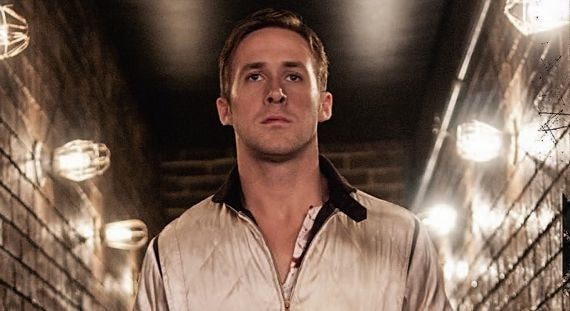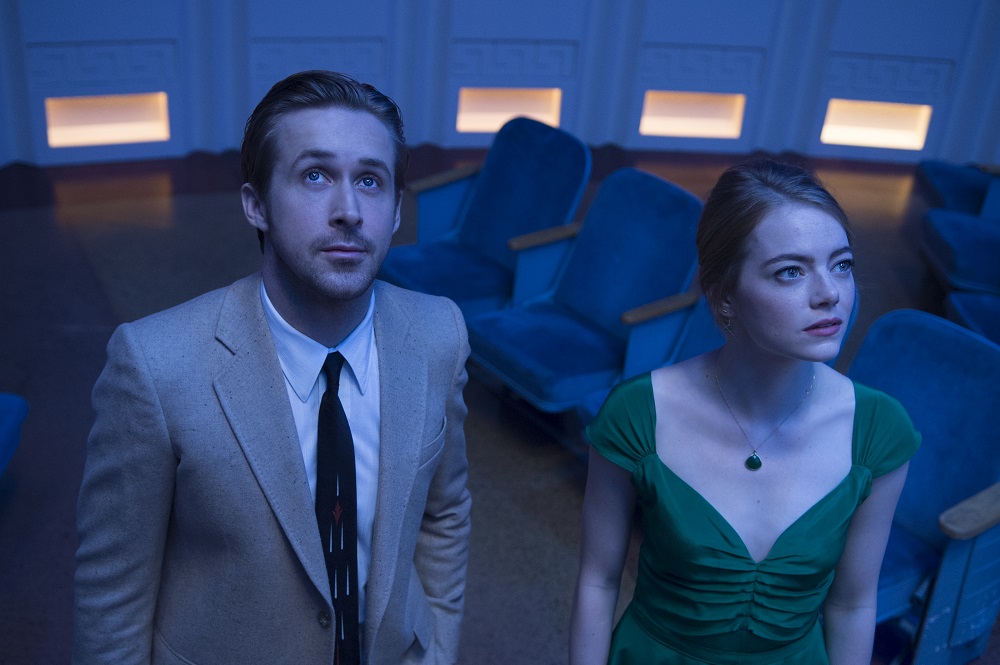Drive | reviews, news & interviews
Drive
Drive
Ryan Gosling's brilliant, bruising ride into LA darkness

Irene (Carey Mulligan) realises just how much the Driver (Ryan Gosling) loves her as his boot caves in a man’s face on the floor of her apartment building lift. They have just kissed for the first time, and she tumbles from him, shaken and repelled.
As its nameless hero, Gosling doesn’t speak for Drive’s first 10 minutes, and is so still in one early scene he looks plastic, only a flick of a finger confirming he breathes, let alone sweats. We see him move smoothly between three high-pressure jobs: getaway driver, Hollywood stunt driver and stock-car racer for his friend, greedy, unlucky old-timer Shannon (Bryan Cranston), who has sought investment from Eighties action-movie producer and current mid-level Jewish mobster, Bernie (Albert Brooks).
Gosling is in an easygoing romcom, Crazy, Stupid, Love, this week too, but a better comparison is the upcoming George Clooney political drama The Ides of March, in which Gosling plays a campaign aide who shares the Driver’s clean-cut, healthy squareness, concealing dangerously unknowable depths.
Mulligan says little more as his apartment-block neighbour, waiting with her little boy Benicio for her husband to get out of jail. They communicate in looks of minutely tremulous longing. She seems to glow when he sees her, an idealised angel, “the best thing that ever happened to me”. Mulligan still makes her frailly real. And when the husband turns up, trailing bad debts to bad men that make the Driver decide to help him on a heist that goes bloodily wrong, the plot becomes a spider web, each thread trailing carnage. Gosling briefly plays him as a blood-spattered nervous wreck when the killing starts, his ice-cool shell cracked, only the desire to protect precious Irene keeping him moving through impossible odds. This is crazy, stupid, doomed love.
The story plays out in a closed world of mid-level criminals and victims, LA noir terrain of anonymous apartment buildings, B-movie sets and pizzerias
Refn’s direction in Drive’s early scenes is all smooth glides and stops, unspoken tensions intimating the disfiguring jolts of panic and violence to come. After his not quite satisfactory British excursions Bronson (2006) and Valhalla Rising (2009), Drive returns the Dane to the dark swagger of his early films - the fated criminality of Pusher (1996), and even crueller romance of Bleeder (1999), which finished with its anti-hero crucified with HIV-infecting syringes. His penchant for sudden, stylised violence sees Gosling hold a hammer and nail over an eye, as topless strippers sit unconcerned in a pulp tableau. Gosling sought him out when Drive was mooted, and its success and his Best Director prize at Cannes have allowed him Hollywood redemption, after his previous US film, Fear X (2003), nearly destroyed his career.
The story plays out in a closed world of mid-level criminals and victims, LA noir terrain of anonymous apartment buildings, B-movie sets and pizzerias. It’s adapted from the novel of the same name by James Sallis, a poetic, humane crime writer whose share in the film’s success will be richly deserved. Cliff Martinez’s pounding synth-rock score meanwhile makes it feel like Refn is remaking some lost 1980s classic of existential action cool – John Carpenter at his most ruthless, or maybe something produced by Drive’s Bernie, played by Albert Brooks, once a sort of LA Woody Allen, here a late-middle-aged urbane mobster who guts arteries with his razor if you let him get close. Like everyone here, he’s surprisingly, perfectly cast. Christina Hendricks, forsaking her pneumatically stylish Mad Men dresses for stilettos and unflattering jeans, burns in a barely written role as a fearful moll.
Drive should confirm Ryan Gosling as the star of the moment, and let Refn leave low-budget purgatory to resume his course as a major director. Though the sum of its parts is quite conventional, those parts glisten and purr.
RYAN GOSLING'S FILMOGRAPHY
Blue Valentine (2010). A controversial break-up melodrama sees things from the male point of view
 Drive (2011). Ryan Gosling's brilliant, bruising ride into LA darkness (pictured)
Drive (2011). Ryan Gosling's brilliant, bruising ride into LA darkness (pictured)
Crazy, Stupid, Love (2011). Ryan Gosling teaches Steve Carell how to score in a film that doesn't
The Ides of March (2011). George Clooney's star-packed morality tale superbly anatomises political chicanery
The Place Beyond the Pines (2013). Derek Cianfrance and Ryan Gosling follow Blue Valentine with an epic tale of cops and robbers
Gangster Squad (2013). Ruben Fleischer swaps zombies for gangsters with mixed results
 Only God Forgives (2013). Nicolas Winding Refn and Ryan Gosling follow Drive with a simmering tale of vengeance
Only God Forgives (2013). Nicolas Winding Refn and Ryan Gosling follow Drive with a simmering tale of vengeance
The Big Short (2015). Director Adam McKay successfully makes a drama out of a crisis
The Nice Guys (2016). Russell Crowe and Ryan Gosling buddy up to crack jokes, bones and crime in 70s LA
La La Land (2017). Ryan Gosling and Emma Stone (pictured above) will have you floating out of the cinema on a cloud
rating
Share this article
The future of Arts Journalism
You can stop theartsdesk.com closing!
We urgently need financing to survive. Our fundraising drive has thus far raised £49,000 but we need to reach £100,000 or we will be forced to close. Please contribute here: https://gofund.me/c3f6033d
And if you can forward this information to anyone who might assist, we’d be grateful.

Subscribe to theartsdesk.com
Thank you for continuing to read our work on theartsdesk.com. For unlimited access to every article in its entirety, including our archive of more than 15,000 pieces, we're asking for £5 per month or £40 per year. We feel it's a very good deal, and hope you do too.
To take a subscription now simply click here.
And if you're looking for that extra gift for a friend or family member, why not treat them to a theartsdesk.com gift subscription?
more Film
 Steve review - educator in crisis
Cillian Murphy excels as a troubled headmaster working with delinquent boys
Steve review - educator in crisis
Cillian Murphy excels as a troubled headmaster working with delinquent boys
 Can I get a Witness? review - time to die before you get old
Ann Marie Fleming directs Sandra Oh in dystopian fantasy that fails to ignite
Can I get a Witness? review - time to die before you get old
Ann Marie Fleming directs Sandra Oh in dystopian fantasy that fails to ignite
 Happyend review - the kids are never alright
In this futuristic blackboard jungle everything is a bit too manicured
Happyend review - the kids are never alright
In this futuristic blackboard jungle everything is a bit too manicured
 Robert Redford (1936-2025)
The star was more admired within the screen trade than by the critics
Robert Redford (1936-2025)
The star was more admired within the screen trade than by the critics
 Blu-ray: The Sons of Great Bear
DEFA's first 'Red Western': a revisionist take on colonial expansion
Blu-ray: The Sons of Great Bear
DEFA's first 'Red Western': a revisionist take on colonial expansion
 Spinal Tap II: The End Continues review - comedy rock band fails to revive past glories
Belated satirical sequel runs out of gas
Spinal Tap II: The End Continues review - comedy rock band fails to revive past glories
Belated satirical sequel runs out of gas
 Downton Abbey: The Grand Finale review - an attemptedly elegiac final chapter haunted by its past
Noel Coward is a welcome visitor to the insular world of the hit series
Downton Abbey: The Grand Finale review - an attemptedly elegiac final chapter haunted by its past
Noel Coward is a welcome visitor to the insular world of the hit series
 Islands review - sunshine noir serves an ace
Sam Riley is the holiday resort tennis pro in over his head
Islands review - sunshine noir serves an ace
Sam Riley is the holiday resort tennis pro in over his head
 theartsdesk Q&A: actor Sam Riley on playing a washed-up loner in the thriller 'Islands'
The actor discusses his love of self-destructive characters and the problem with fame
theartsdesk Q&A: actor Sam Riley on playing a washed-up loner in the thriller 'Islands'
The actor discusses his love of self-destructive characters and the problem with fame
 Honey Don’t! review - film noir in the bright sun
A Coen brother with a blood-simple gumshoe caper
Honey Don’t! review - film noir in the bright sun
A Coen brother with a blood-simple gumshoe caper
 The Courageous review - Ophélia Kolb excels as a single mother on the edge
Jasmin Gordon's directorial debut features strong performances but leaves too much unexplained
The Courageous review - Ophélia Kolb excels as a single mother on the edge
Jasmin Gordon's directorial debut features strong performances but leaves too much unexplained

Add comment